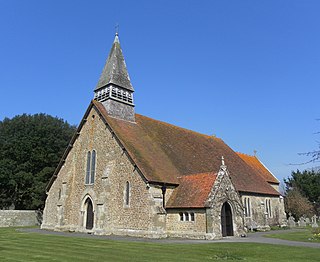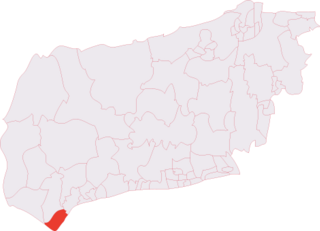
The Kingdom of the South Saxons, today referred to as the Kingdom of Sussex, was one of the seven traditional kingdoms of the Heptarchy of Anglo-Saxon England. On the south coast of the island of Great Britain, it was originally a sixth-century Saxon colony and later an independent kingdom. The kingdom remains one of the least known of the Anglo-Saxon polities, with no surviving king-list, several local rulers and less centralisation than other Anglo-Saxon kingdoms. The South Saxons were ruled by the kings of Sussex until the country was annexed by Wessex, probably in 827, in the aftermath of the Battle of Ellendun.

West Sussex is a county in South East England on the English Channel coast. The ceremonial county comprises the districts of Adur, Arun, Chichester, Horsham, and Mid Sussex, and the boroughs of Crawley and Worthing. Covering an area of 1,991 square kilometres, West Sussex borders Hampshire to the west, Surrey to the north, and East Sussex to the east. The county town and only city in West Sussex is Chichester, located in the south-west of the county. In the 2011 census, West Sussex recorded a population of 806,900.

Selsey is a seaside town and civil parish, about eight miles (12 km) south of Chichester in West Sussex, England. Selsey lies at the southernmost point of the Manhood Peninsula, almost cut off from mainland Sussex by the sea. It is bounded to the west by Bracklesham Bay, to the north by Broad Rife, to the east by Pagham Harbour and terminates in the south at Selsey Bill. There are significant rock formations beneath the sea off both of its coasts, named the Owers rocks and Mixon rocks. Coastal erosion has been an ever-present problem for Selsey.
Earnley is a civil and ecclesiastical parish in the Chichester District of West Sussex, England. It is located four miles (6.4 km) south-west of Chichester, and lies on the south coast of England. The parish includes the settlements of Almodington and Batchmere.

Æthelwealh was ruler of the ancient South Saxon kingdom from before 674 till his death between 680 and 685. He was baptised in Mercia, becoming the first Christian king of Sussex. He was killed by a West Saxon prince, Cædwalla, who eventually became king of Wessex.

Selsey Football Club is a Semi-professional football club based in Selsey, West Sussex, England. The club is a FA Chartered Standard Community club affiliated to the Sussex County Football Association. The club are currently members of the Southern Combination Division One and play at the High Street Ground.

Selsey Bill is a headland into the English Channel on the south coast of England in the county of West Sussex.

The Bishop of Chichester is the ordinary of the Church of England Diocese of Chichester in the Province of Canterbury. The diocese covers the counties of East and West Sussex. The see is based in the City of Chichester where the bishop's seat is located at the Cathedral Church of the Holy Trinity. On 3 May 2012 the appointment was announced of Martin Warner, Bishop of Whitby, as the next Bishop of Chichester. His enthronement took place on 25 November 2012 in Chichester Cathedral.

Selsey Abbey was founded by St Wilfrid in AD 681 on land donated at Selsey by the local Anglo-Saxon ruler, King Æðelwealh of Sussex, Sussex's first Christian king. The Kingdom of Sussex was the last area of Anglo-Saxon England to be evangelised.
The Haestingas, or Heastingas or Hæstingas, were one of the tribes of Anglo-Saxon Britain. Not very much is known about them. They settled in what became East Sussex sometime before the end of the 8th century. A 12th-century source suggested that they were conquered by Offa of Mercia, in 771. They were also recorded in the Anglo-Saxon Chronicle (ASC) as being an autonomous grouping as late as the 11th century.
Cymenshore is a place in Southern England where, according to the Anglo-Saxon Chronicle, Ælle of Sussex landed in AD 477 and battled the Britons with his three sons Cymen, Wlencing and Cissa, after the first of whom Cymenshore was held to have been named. Its location is unclear but was probably near Selsey.

St Peter's Church is the Parish Church of Selsey, West Sussex and dates from the 13th century. The Church building was originally situated at the location of St Wilfrid's first monastery and cathedral at Church Norton some 2 miles north of the present centre of population.

The Manhood Peninsula is the southwest of West Sussex in England. It has the English Channel to its south and Chichester to the north. It is bordered to its west by Chichester Harbour and to its east by Pagham Harbour, its southern headland being Selsey Bill.

Selsey is an electoral division of West Sussex in the United Kingdom, and returns one member to sit on West Sussex County Council.

St Wilfrid's Chapel, also known as St Wilfrid's Church and originally as St Peter's Church, is a former Anglican church at Church Norton, a rural location near the village of Selsey in West Sussex, England. In its original, larger form, the church served as Selsey's parish church from the 13th century until the mid 1860s; when half of it was dismantled, moved to the centre of the village and rebuilt along with modern additions. Only the chancel of the old church survived in its harbourside location of "sequestered leafiness", resembling a cemetery chapel in the middle of its graveyard. It was rededicated to St Wilfrid—7th-century founder of a now vanished cathedral at Selsey—and served as a chapel of ease until the Diocese of Chichester declared it redundant in 1990. Since then it has been in the care of the Churches Conservation Trust charity. The tiny chapel, which may occupy the site of an ancient monastery built by St Wilfrid, is protected as a Grade I Listed building.

The Academy Selsey, formerly the Manhood Community College and the Manhood Secondary Modern School, is an small co-educational non-selective academy for 11 to 16-year-old children, in the village of Selsey, on the Manhood Peninsula, just south of Chichester, West Sussex It is part of The Kemnal Academies Trust; the multi-academy trust that oversees a number of secondary and primary schools in Kent and the south-east of England.
Sussex in the High Middle Ages includes the history of Sussex from the Norman Conquest in 1066 until the death of King John, considered by some to be the last of the Angevin kings of England, in 1216. It was during the Norman period that Sussex achieved its greatest importance in comparison with other English counties. Throughout the High Middle Ages, Sussex was on the main route between England and Normandy, and the lands of the Anglo-Norman nobility in what is now western France. The growth in Sussex's population, the importance of its ports and the increased colonisation of the Weald were all part of changes as significant to Sussex as those brought by the neolithic period, by the Romans and the Saxons. Sussex also experienced the most radical and thorough reorganisation of land in England, as the Normans divided the county into five tracts of lands called rapes. Although Sussex may have been divided into rapes earlier in its history, under the Normans they were clearly administrative and fiscal units. Before the Norman Conquest Sussex had the greatest concentration of lands belonging to the family of Earl Godwin. To protect against rebellion or invasion, the scattered Saxon estates in Sussex were consolidated into the rapes as part of William the Conqueror's 'Channel march'.
Elections to Chichester District Council in West Sussex, United Kingdom were held on 3 May 1979, the same day as the general election.












